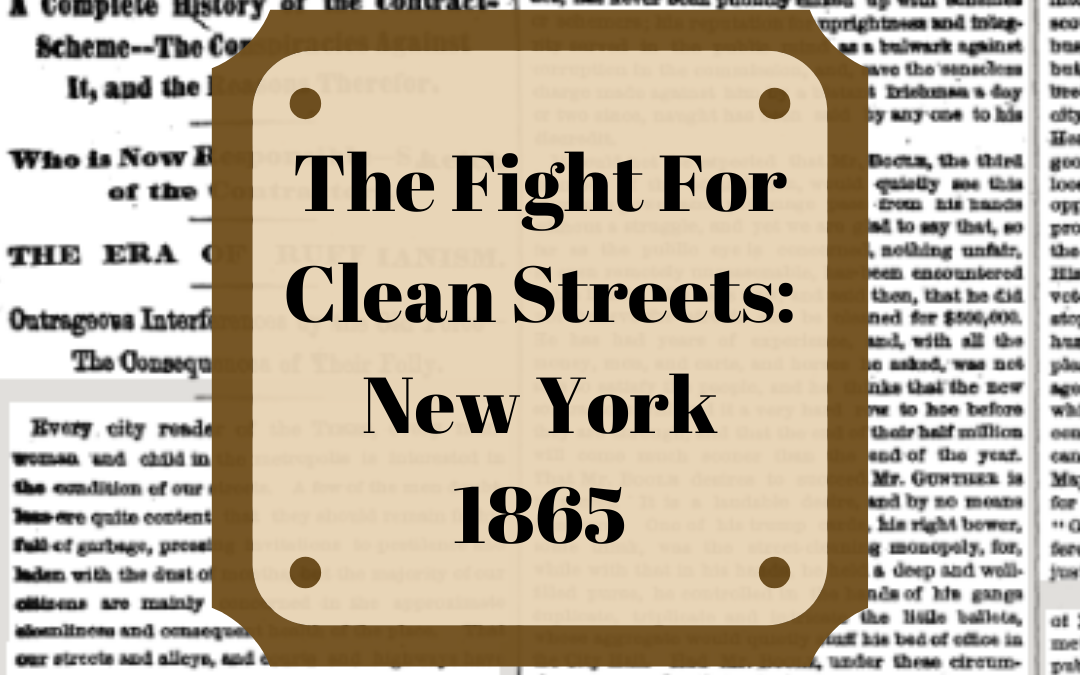The Fight for Clean Streets: New York 1865
Here at Dare, a big part of our job is to sweep and clean commercial properties. When it comes to keeping public streets clean, it’s up to the municipalities that govern those areas. Both areas require regular sweeping, cleaning, and trash removal. Without these essential services debris piles up, dust piles up, and the risk to public health rises. Writing this blog in the midst of the 2020 COVID-19 pandemic reinforces the importance of clean streets and properties. Anywhere there’s people, there should be workers keeping it clean and safe. This month’s blog is about not taking these services for granted by learning from New York City’s fight for clean streets.
On July 19, 1865 the New York Times published an article detailing the city’s struggle for clean streets. The article can be read in full here. Back then, New York City was filthy. Horses and other animals defecated in the streets, garbage was left to rot, and dust filled the air. It was a horribly unpleasant place to inhabit. Even dead animals were sometimes left where they fell, rotting away while pedestrians walked by; it was a brutal time. The inhabitants of New York knew they deserved better though:
The people demand clean streets; they have made up their minds that those who stand in the way of this consummation are selfish, unprincipled and cowardly, and must be swept from the path.
The city government began to feel the pressure after years of ignoring the city’s dire condition. There were men in charge of the city’s cleanliness but corruption resulted in little being done. Those in charge would spend as little money as possible on sanitation purposes and what little they spent was, “…really to put money in the wallets of contractors and politicians, and votes in the ballot-box on election day.” It’s important to remember that voting laws and politics in general were drastically different in 1865. While most common people didn’t have a voice in the polls, they still had a voice. Pressure continued to mount:
Reports of Health Physicians have informed that mysterious body known as the Board of Health, that unless something was done, disease and death would sweep the city; the philanthropists have waded knee deep in mud and garbage that they might gather facts which would force the authorities to take immediate notice of our distressing condition; the TIMES has gone literally into streets whose offensive odor upset its hardened stomach, where festering slime reposed in undisturbed security on the face of long-neglected puddles, where stenchful mud and putrid piles of offal-bred big black flies and little children died daily of dysentery, diarrhoea and neglect, and these facts have been spread before the authorities — with what result? An increased appropriation to the Inspector’s office, a few bombastic resolutions, but no practical end.
Eventually those in charged were forced to act and put real money into keeping the city clean. The city government allocated $500,000 dollars to clean up the streets and keep them clean. A team of three contractors were awarded the contract and the team set to work. The first thing they had to do was find a crew. The city government told the contractors that they already had crews in position:
“We Aldermen have appointed inspectors in each ward; they are familiar with the streets and places; they know the fever nests that abound in every locality; they superintend the foremen, who in turn have charge of the laborers, and you can’t do a better thing for yourselves than to employ these same inspectors and foremen.” The good sense of this was apparent to Mr. BROWN and his associates [the contractors], as it would be to any men who supposed they were dealing with gentlemen, but the folly of following it soon became much more apparent…
…Certain scheming members of our City Government, aided and abetted by their creatures and friends, secretly convinced the laborers that the new contractors were hostile to the interests of the workingmen, would lower wages at once, and replace such as were discontented by men of their own selection…
…To their utter horror and astonishment, the contractors learned on the night of the 30th of June, that the men on whom they were depending refused to work…
…The 1st of July came, but with it we saw no gangs of cleaners, the whist of the broom and the rattle of the shovel were missed from the few and favored localities where they were wont to be heard, and dust settled like a pall upon everything…

“The June 22, 1895, edition of Harper’s Weekly compared photos of the same street corners two years earlier to show what an incredible transformation street cleaning had effected. Via the New York Public Library.” Credit: Collectors Weekly.com
The story doesn’t go into detail why certain politicians convinced the workers that the contractors did not have their best interests in mind but one can assume it was for political reasons; perhaps an attempt to make the current government look incompetent or perhaps they had investments with competing contractors. Whatever the reason, the results were utterly awful. The contractors sprang to action and quickly acquired new crews and new equipment. These men set to work cleaning the streets but the original workers (those on strike) did not take kindly to this; and violence erupted on the streets of New York.
Those on strike began attacking those who were sweeping and cleaning the streets; throwing stones, breaking windows, and even whipping some of the workers. Then they targeted the contractors personally by attacking their horses and setting fire to Mr. Brown’s stable. The police were called in to protect the workers and eventually things settled down. As the article states, “Public sympathy does not run with barn-burners nor horse murderers, nor men beaters, but rather with honest toil and modest industry.”
The people wanted clean streets and the honest toil and modest industry of those not swayed by corruption provided exactly that. Unfortunately, this isn’t the end of the story. A few decades later things start to deteriorate once again for old New York. If readers enjoy this article then we will dive into the rest of the story in future blogs and learn more about the fight for clean streets.
The moral of this historic story is to not take clean streets and parking lots for granted. Investing hard work into keeping these areas clean and free of debris keeps everyone healthy and safe. This story shows us that the things we find commonplace today, were once things that had to be fought for.
This was the fight for clean streets!
Ready to learn how you can clean up your commercial property?





